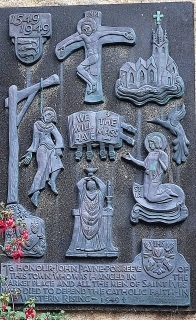A tiny chapel and a Catholic martyr both in a port in Cornwall
WHENEVER WE VISIT the picturesque port of St Ives in Cornwall, we come across things we had not noticed on previous visits. On our latest visit, made in early July 2024, we discovered a monument that we had not noticed before and entered a chapel, which we had seen often, but never entered.
The monument is a bas-relief plaque mounted on one of the walls of the Roman Catholic Sacred Heart and St Ia Church. It is dedicated to the memory of John Payne, the portreeve (harbour master) of St Ives. He was executed in 1549 because he was a Roman Catholic. His demise occurred during the 1549 Prayerbook Rebellion. In case you had never heard of this – and it was news to me – the Prayerbook Rebellion (aka the ‘Western Rising’) happened because of something that happened during the reign of King Edward VI. Edward’s uncle, Edward Seymour, encouraged iconoclasm and the use of English (instead of Latin) during church services. This was unpopular in large parts of England, and when in 1549 the “Book of Common Prayer” was introduced, revolt against it broke out in Devon and Cornwall.

John Payne was hung in the marketplace of St Ives. His death was ordered by Sir Anthony Kingston, the Provost Marshal (c1508-1556). Payne was not the only Cornishman who was executed for his Catholic beliefs. The monument in St Ives is not only dedicated to him but also to:
“… all the men of St Ives who died to defend the Catholic faith in the Western Rising – 1549”
I am not sure when the memorial plaque was placed on the church, but it does bear the dates “1549” and “1949”.
Further into the town than the monument just described, one reaches the Smeaton Pier, where fishing boats unload the seafood, which they have caught. Wedged between a public toilet (for ‘gents’) and the small St Ives Harbour Master’s Office, there is a tiny chapel dedicated to St Leonard. This small building built with stones is entered via a few granite steps. Consisting of a small room (about 10 feet long and 6 feet wide. No one knows when it was constructed, but records indicate that it underwent some repairs in1577. The chapel was probably used by seamen setting out for sea and also provided shelter in bad weather. In 1971, the chapel was renovated and opened as a museum and a memorial to the fishermen of St Ives.
On the outside of the chapel, there is a plaque commemorating the record breaking 600-mile passage made by the St Ives lugger Lloyd from Scarborough to St Ives in 1902. The journey took 50 hours. Within the chapel, there are glass cabinets containing historical maritime items as well as old photographs and some models of sailing ships.
Although small, both the chapel and the memorial add to the fascination of the wonderful town of St Ives. In a future essay, I will tell you about some more of the things we ‘discovered’ during our latest visit to the place.



